Standard: HSA.REI.A2 – Solve simple rational and radical equations in one variable, and give examples showing how extraneous solutions may arise.
Grade level: High School: Algebra
Subject: Mathematics
Domain: Reasoning with Equations & Inequalities
Teacher Overview
This standard involves solving simple rational and radical equations in one variable and understanding the concept of extraneous solutions. Mastery of this standard is crucial as it lays the foundation for more advanced algebraic concepts and problem-solving skills. Students should be comfortable with basic algebra, including solving linear equations and understanding rational and radical expressions. They should also be familiar with basic arithmetic operations involving fractions and roots.
Students will be prepared to solve more complex equations and systems of equations, and apply these skills in higher-level mathematics such as calculus and advanced algebra.
Common Misconception 1
A common misconception is that all solutions derived from solving rational or radical equations are valid. This is incorrect because some solutions may not satisfy the original equation, leading to extraneous solutions.
Intervention 1
To remediate this misconception, have students practice checking their solutions by substituting them back into the original equation. This helps them understand the importance of verifying their results.
Common Misconception 2
Another misconception is that extraneous solutions are errors in their calculations. In reality, these solutions can naturally arise from the algebraic manipulations involved in solving the equations.
Intervention 2
To address this, explain the concept of extraneous solutions and provide examples that illustrate how they occur. Encourage students to identify and exclude these solutions through verification.
Prerequisite Knowledge
Students should have a solid understanding of algebraic manipulation, including how to solve linear equations, and basic knowledge of rational and radical expressions.
Subsequent Knowledge
After mastering this standard, students will be able to tackle more complex equations involving multiple variables and systems of equations, and apply these skills in calculus and advanced algebra.
Instructional Activities
- Work through a variety of rational and radical equation problems as a class.
- Group activities where students solve equations and then check each other’s work for extraneous solutions.
- Interactive online exercises that provide immediate feedback on solving equations.
- Real-world problem scenarios where students apply their skills to practical situations.




